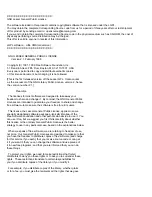
▪
[6]
F MAX
: Adjusts the minimum duration of the pulses created from the feedback signal
by the Timer. This determines the maximum frequency of the pulse signal (in semi
tones relative to the note pitch). It also controls the cutoff of a lowpass filter in the
feedback path.
▪
[7]
LO CUT
: Cutoff (as number of the partials) of the highpass, that controls the amount
of Ratio bending for higher partials.
▪
[8]
RESO
: Resonance of the Exciter's Low Cut (highpass) filter.
▪
[9]
HI CUT
: Static amount of the cutoff frequency of the Exciter's High Cut (2-pole low
pass) filter (semitones).
▪
[10]
RESO
: Resonance of the Exciter's High Cut (lowpass) filter.
▪
[11]
VEL
: Amount of velocity applied to
HI CUT
, the cutoff frequency of the lowpass filter
of the Exciter. The upper limit of the velocity range is given by the value of
HI CUT
, the
lower limit depends on the
VEL
amount.
▪
[12]
TRACK
: Key tracking amount of the cutoff frequencies of the Exciter's Low Cut and
High Cut filters0.0 - no tracking with the key position1.0 - the key position (relative to
C3 = 60) is fully added to the filter cutoffs.
5.8
LFO Section
The polyphonic LFO section contains the controls for a per voice LFO. That means that for
each note, the LFO will be triggered with these settings, so if you play two notes slightly
after each other, they each will have their modulation with their own timing. The LFO rate
can also vary from note to note since it can be influenced by pitch tracking. This is really
powerful for creating per-note vibrato and fade-in effects. The LFO has two selectable tar
gets with their own amounts.
Overview of REAKTOR PRISM Ensemble
LFO Section
REAKTOR PRISM - Manual - 30
Содержание Reaktor Prism
Страница 1: ...Manual...
















































